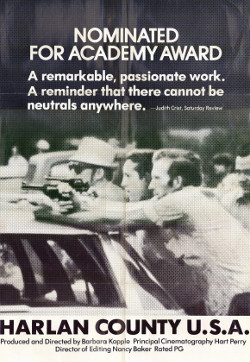
Harlan County U.S.A. (1976)
Director: Barbara Kopple
Runtime: 103 min
A very intense documentary about the famous “Brookside Strike” in 1972/3, when the miners in Harlan County, (Kentucky, USA) went on a strike. The miners have decided to join the United Miners of America (UMWA) trade union, and then they insisted that the company which owns the mine signs a collective agreement with the UMWA. The company refused, and so began the strike that lasted for over a year.
The director-cinematographer Barbara Kopple spent several years living with the miners in Harlan, and during the strike she has managed to capture some remarkable scenes, the most remarkable one being the miners’ wifes who practically led the strike when the men became weary of physical clashes between the miners and armed strikebreakers. In the end, one of the strikebreakers killed one miner, and only after that incident the company agreed to the signing of the contract and some other requests put forward by the miners.
This film portrays, in a very clear and unambiguous manner, how the whole system stands in the service of the company, and against the miners. From politicians and the police, to the judge who unjustly sentenced the workers to two months in prison for obstructing traffic because they tried to prevent the passage of strikebreakers. On the other hand, the miners and their wives are openly aware of their social belonging and highly appreciate workers’ organizing and solidarity, although we never see an open anti-capitalist engagement in the form of advocacy for a different social order.
Initially Barbara Kopple intended to make a film about the movement called “Miners for Democracy”, which emerged within the rank-and-file UMWA, with the aim to overthrow the corrupt union leadership that was more concerned about protecting the mining company than protecting the miners. In 1969, the UMWA president Tony Boyle faked the intra-union elections and subsequently ordered the killing of the opposing candidate. In 1972, “Miners for Democracy” finally managed to replace Boyle, and that contributed to an atmosphere of combativeness throughout the organization. When the strike began in June of 1972, Kopple focused on the strike and decided to change the whole concept of the film.
It should be borne in mind that the world of miners’ unions in USA and the class struggle in the form shown in this documentary no longer exists in this form as it was destroyed during the eighties in reganist neo-conservative (neoliberal) counter-revolution and the relocation of primary production to the countries of the periphery of the world system.
You can download this film or watch it online.

